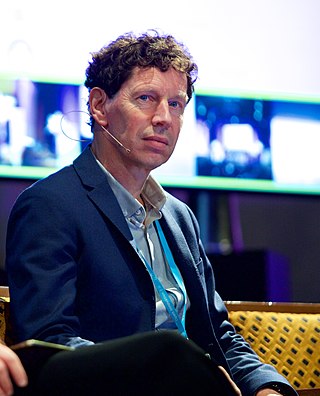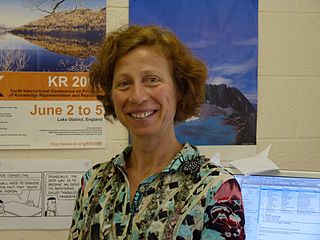
The Semantic Web, sometimes known as Web 3.0, is an extension of the World Wide Web through standards set by the World Wide Web Consortium (W3C). The goal of the Semantic Web is to make Internet data machine-readable.
The Web Ontology Language (OWL) is a family of knowledge representation languages for authoring ontologies. Ontologies are a formal way to describe taxonomies and classification networks, essentially defining the structure of knowledge for various domains: the nouns representing classes of objects and the verbs representing relations between the objects.
Semantic similarity is a metric defined over a set of documents or terms, where the idea of distance between items is based on the likeness of their meaning or semantic content as opposed to lexicographical similarity. These are mathematical tools used to estimate the strength of the semantic relationship between units of language, concepts or instances, through a numerical description obtained according to the comparison of information supporting their meaning or describing their nature. The term semantic similarity is often confused with semantic relatedness. Semantic relatedness includes any relation between two terms, while semantic similarity only includes "is a" relations. For example, "car" is similar to "bus", but is also related to "road" and "driving".
Semantic integration is the process of interrelating information from diverse sources, for example calendars and to do lists, email archives, presence information, documents of all sorts, contacts, search results, and advertising and marketing relevance derived from them. In this regard, semantics focuses on the organization of and action upon information by acting as an intermediary between heterogeneous data sources, which may conflict not only by structure but also context or value.
Ontology alignment, or ontology matching, is the process of determining correspondences between concepts in ontologies. A set of correspondences is also called an alignment. The phrase takes on a slightly different meaning, in computer science, cognitive science or philosophy.
Simple Knowledge Organization System (SKOS) is a W3C recommendation designed for representation of thesauri, classification schemes, taxonomies, subject-heading systems, or any other type of structured controlled vocabulary. SKOS is part of the Semantic Web family of standards built upon RDF and RDFS, and its main objective is to enable easy publication and use of such vocabularies as linked data.

Ian Robert Horrocks is a professor of computer science at the University of Oxford in the UK and a Fellow of Oriel College, Oxford. His research focuses on knowledge representation and reasoning, particularly ontology languages, description logic and optimised tableaux decision procedures.

Frank van Harmelen is a Dutch computer scientist and professor in Knowledge Representation & Reasoning in the AI department at the Vrije Universiteit Amsterdam. He was scientific director of the LarKC project (2008-2011), "aiming to develop the Large Knowledge Collider, a platform for very large scale semantic web reasoning."
Ontology-based data integration involves the use of one or more ontologies to effectively combine data or information from multiple heterogeneous sources. It is one of the multiple data integration approaches and may be classified as Global-As-View (GAV). The effectiveness of ontology‑based data integration is closely tied to the consistency and expressivity of the ontology used in the integration process.
The terms schema matching and mapping are often used interchangeably for a database process. For this article, we differentiate the two as follows: schema matching is the process of identifying that two objects are semantically related while mapping refers to the transformations between the objects. For example, in the two schemas DB1.Student and DB2.Grad-Student ; possible matches would be: DB1.Student ≈ DB2.Grad-Student; DB1.SSN = DB2.ID etc. and possible transformations or mappings would be: DB1.Marks to DB2.Grades.

In computer science, information science and systems engineering, ontology engineering is a field which studies the methods and methodologies for building ontologies, which encompasses a representation, formal naming and definition of the categories, properties and relations between the concepts, data and entities of a given domain of interest. In a broader sense, this field also includes a knowledge construction of the domain using formal ontology representations such as OWL/RDF. A large-scale representation of abstract concepts such as actions, time, physical objects and beliefs would be an example of ontological engineering. Ontology engineering is one of the areas of applied ontology, and can be seen as an application of philosophical ontology. Core ideas and objectives of ontology engineering are also central in conceptual modeling.
Minimal mappings are the result of an advanced technique of semantic matching, a technique used in computer science to identify information which is semantically related.
Semantic matching is a technique used in computer science to identify information which is semantically related.
A lightweight ontology is an ontology or knowledge organization system in which concepts are connected by rather general associations than strict formal connections. Examples of lightweight ontologies include associative network and multilingual classifications but the term is not used consistently.

Ulrike M. Sattler is a professor of computer science in the information management group of the Department of Computer Science at the University of Manchester and a visiting professor at the University of Oslo.

In information science a conceptualization is an abstract simplified view of some selected part of the world, containing the objects, concepts, and other entities that are presumed of interest for some particular purpose and the relationships between them. An explicit specification of a conceptualization is an ontology, and it may occur that a conceptualization can be realized by several distinct ontologies. An ontological commitment in describing ontological comparisons is taken to refer to that subset of elements of an ontology shared with all the others. "An ontology is language-dependent", its objects and interrelations described within the language it uses, while a conceptualization is always the same, more general, its concepts existing "independently of the language used to describe it". The relation between these terms is shown in the figure to the right.
The Extended Semantic Web Conference, formerly known as the European Semantic Web Conference, is a yearly international academic conference on the topic of the Semantic Web. The event began in 2004, as the European Semantic Web Symposium. The goal of the event is "to bring together researchers and practitioners dealing with different aspects of semantics on the Web".
Natasha Fridman Noy is a Russian-born American Research scientist who works at Google Research in Mountain View, CA, who focuses on making structured data more accessible and usable. She is the team leader for Dataset Search, a web-based search engine for all datasets. Natasha worked at Stanford Center for Biomedical Informatics Research before joining Google, where she made significant contributions to ontology building and alignment, as well as collaborative ontology engineering. Natasha is on the Editorial Boards of many Semantic Web and Information Systems publications and is the Immediate Past President of the Semantic Web Science Association. From 2011 to 2017, she was the president of the Semantic Web Science Association.

Pascal Hitzler is a German American computer scientist specializing in Semantic Web and Artificial Intelligence. He is endowed Lloyd T. Smith Creativity in Engineering Chair, one of the Directors of the Institute for Digital Agriculture and Advanced Analytics (ID3A) and Director of the Center for Artificial Intelligence and Data Science (CAIDS) at Kansas State University, and the founding Editor-in-Chief of the Semantic Web journal and the IOS Press book series Studies on the Semantic Web.

In knowledge representation and reasoning, a knowledge graph is a knowledge base that uses a graph-structured data model or topology to represent and operate on data. Knowledge graphs are often used to store interlinked descriptions of entities – objects, events, situations or abstract concepts – while also encoding the semantics or relationships underlying these entities.








